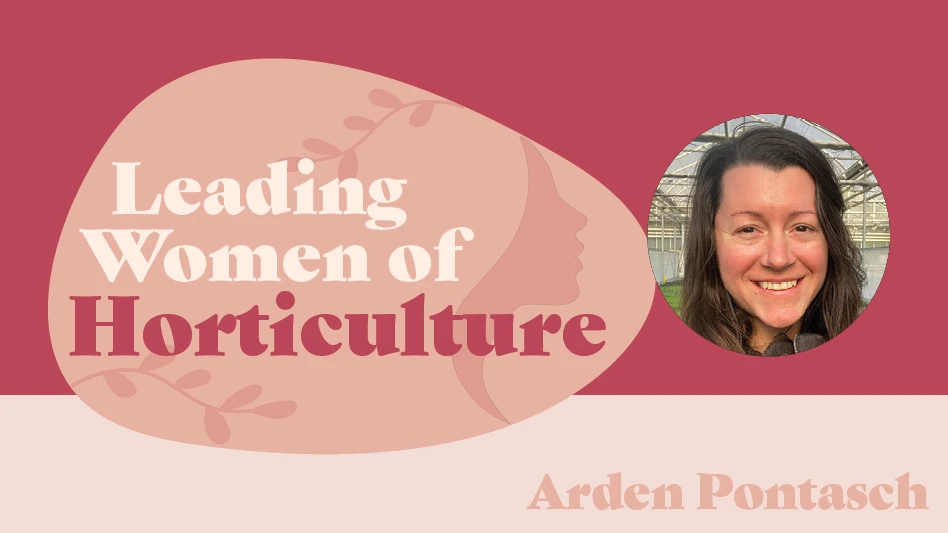At a cost of $1-$2 per square foot, high tunnels can add low-cost growing space for season extension for plant protection. Growers and researchers are finding many innovative ways to use these structures to supplement greenhouse operations.
{sidebar id=52}
By definition, a high tunnel is a walk-in, hoop or gothic-shaped pipe-frame structure covered with a single layer of plastic film. It generally does not have electricity and the only heat is provided by the sun. Ventilation is provided by rolling up the sidewalls and opening the doors. Irrigation water is supplied by piping from another building. Plant production can be directly in the soil or in containers on top of a weed mat. A multi-bay tunnel is available from Haygrove Tunnels in
High tunnels have their roots in
High tunnel crops
The tunnels have been used to produce early-spring tomatoes, peppers and cucumbers. Plants started in a growth chamber or propagation greenhouse are moved into the tunnel about a month before they could normally be planted outdoors. This allows the vegetables to be available for market earlier when prices are higher.
A relatively new use of high tunnels is to produce specialty cut flowers. Most flowers that do well outdoors will do better indoors with a modified environment. Eliminating the wind and rain usually improves quality and shortens the growing season.
Some of the most popular flower species for high tunnels are aster, delphinium, dianthus, echinacea, snapdragon, sunflower and zinnia. Flowers are usually sold to retail florists, roadside stands and farm markets. In some areas, pick-your-own areas are popular.
In nursery operations, high tunnels are common in the North for winter protection of nursery stock, perennials and herbs. In
Container nursery plants are placed pot-to-pot on gravel or weed barrier mat. The tunnel, covered with white polyethylene, provides wind and temperature protection. Irrigation may be needed if the weather is warm for an extended time. Ventilation is accomplished by opening the endwall doors. A layer of foam insulation may be placed over low-temperature-sensitive plants to provide additional protection.
Some growers have used high tunnels in place of cold frames for hardening-off early-season crops such as pansies, snapdragons and vegetable transplants. Instead of adding expensive greenhouse space that may only be needed for a month in spring, high tunnels can provide the space needed at a much lower cost.
Another application for high tunnel technology is in the production of small fruit. Strawberries, raspberries and other small fruit do very well as the modified environment increases yields as well as earliness. The choice of cultivars, planting time and spacing are critical to producing a good crop.
Tunnel construction
Site selection is important. As solar heating and natural ventilation are the means of temperature and humidity control, it is important to locate the tunnel away from buildings and trees. If crops are grown directly in the soil, add organic matter and amendments and test the soil. Install a swale around the greenhouse to drain away rainwater.
Steel tubing or fence pipe is the standard material used for the hoops. Drive posts into the ground about 2 feet deep to support the hoops. To get a higher ridge and better ventilation, the ground posts are sometimes extended 2-4 feet above grade. Bolt a 2-by-12-inch pressure-treated lumber baseboard to the posts to help make the frame rigid. Make the endwall frame and doors of 2-by-4-inch lumber.
Create doors large enough to allow access for a small tractor if the ground will be tilled. If the crops will be grown in the soil, install the structure so that it can be easily moved from one location to another.
Widths of 14-20 feet are the most common, but some manufacturers make structures as wide as 30 feet. Although the length can be any multiple of the 4-foot hoop spacing, a 48- or 96-foot length will use the 100-foot sheets of plastic film better. It is best to install the stronger 6-mil greenhouse grade of polyethylene that will give four years of service rather than agricultural-grade plastic, which usually deteriorates in less than one year. In windy locations, a woven polyethylene has given better service.
A hip board attached to the frames 3-4 feet above the baseboard will hold the plastic when the roll-up sides are open. Attach the plastic to the baseboard and hip board with aluminum extrusions or a double furring strip for a tight seal and easy replacement.
Crop basics
Here are the basics for ventilation, heating and irrigation in high tunnels.
Ventilation. Except for the multi-bay, gutter-connected style tunnel that ventilates by opening up the plastic roof, cooling is by roll-up sides and endwall doors. Ken-Bar Inc. in
Heating. To gain extra production time for crops such as tomatoes, cucumbers and peppers, install a root-zone heating system. This system uses a propane gas hot-water heater, circulating pump, 3/4-inch-diameter poly pipe placed 12 inches below the soil surface and a remote bulb thermostat to maintain a 70°F-75°F soil temperature in the root zone. Electricity will be needed to operate the pump. A standby portable propane heater could also be used for cold nights.
Irrigation. Irrigation water is needed for the plants. If zoned properly, several high tunnels may be supplied by a 1-inch poly pipeline. If tunnels are a distance from a water supply, a trailer-mounted tank can provide water. For crops grown in rows or in containers, a drip system will reduce the amount of water needed.
Although high tunnels can’t provide the same environment as a greenhouse, they can offer growers the opportunity to have additional production space during spring and fall for crops that are not as temperature sensitive. They do require more attention and maintenance.
{sidebar id=1}
- John W. Bartok Jr.
Get curated news on YOUR industry.
Enter your email to receive our newsletters.Latest from Nursery Management
- Society of American Florists accepting entries for 2025 Marketer of the Year Contest
- Sustainabloom launches Wholesale Nickel Program to support floriculture sustainability
- American Horticultural Society welcomes five new board members
- Get to know Christopher Brown Jr. of Lancaster Farms
- American Floral Endowment establishes Demaree Family Floriculture Advancement Fund
- The Growth Industry Episode 3: Across the Pond with Neville Stein
- The Growth Industry Episode 2: Emily Showalter on how Willoway Nurseries transformed its business
- March 2025 issue recap






